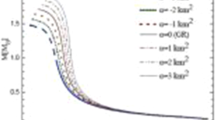Abstract
We used a multipolar code to create, through dissipationless collapses of systems of 106 particles, two cuspy self-consistent triaxial stellar systems with γ ≈ 1. One of the systems has an axial ratio similar to that of an E4 galaxy and it is only mildly triaxial (T = 0.914), while the other one is strongly triaxial (T = 0.593) and its axial ratio lies in between those of Hubble types E5 and E6. Both models rotate although their total angular momenta are zero, i.e., they exhibit figure rotation. The angular velocity is very small for the less triaxial model and, while it is larger for the more triaxial one, it is still comparable to that found by Muzzio (Celest Mech Dynam Astron 96(2):85–97, 2006) to affect only slightly the dynamics of a similar model. Except for minor evolution, probably caused by unavoidable relaxation effects of the N-body code, the systems are highly stable. The potential of each system was subsequently approximated with interpolating formulae yielding smooth potentials, stationary in frames that rotate with the models. The Lyapunov exponents could then be computed for randomly selected samples of the bodies that make up the two systems, allowing the recognition of regular and of partially and fully chaotic orbits. Finally, the regular orbits were Fourier analyzed and classified using their locations on the frequency map. Most of the orbits are chaotic, and by a wide margin: less than 30% of the orbits are regular in our most triaxial model. Regular orbits are dominated by tubes, long axis ones in the less triaxial model and short axis tubes in the more triaxial one. Most of the boxes are resonant (i.e., they are boxlets), as could be expected from cuspy systems.
Similar content being viewed by others
References
Aguilar L.A., Merritt D.: The structure and dynamics of galaxies formed by cold dissipationless collapse. Astrophys. J. 354, 33–51 (1990)
Aquilano R.O., Muzzio J.C., Navone H.D., Zorzi A.F.: Orbital structure of self-consistent triaxial stellar systems. Celest. Mech. Dynam. Astron. 99(4), 307–324 (2007)
Binney J., Spergel D.: Spectral stellar dynamics. Astrophys. J. 252, 308–321 (1982)
Binney J., Tremaine S.: Galactic Dynamics. Princeton University Press, Princeton, NJ (2008)
Carpintero D.D., Aguilar L.A.: Orbit classification in arbitrary 2D and 3D potentials. MNRAS 298(1), 1–21 (1998)
Carpintero D.D., Wachlin F.C.: Sensitivity of the orbital content of a model stellar system to the potential approximation used to describe it. Celest. Mech. Dynam. Astron. 96(2), 129–136 (2006)
Contopoulos G.: Order and Chaos in Dynamical Astronomy. Springer, Berlin (2002)
Forbes D.A., Ponman T.J.: On the relationship between age and dynamics in elliptical galaxies. Mon. Not. R. Astron. Soc. 309, 623–628 (1999)
Hernquist L., Barnes J.: Are some N-body algorithms intrinsically less collisional than others?. Astrophys. J. 349, 562–569 (1990)
Hernquist L., Ostriker J.P.: A self-consistent field method for galactic dynamics. Astrophys. J. 386(20), 375–397 (1992)
Holley-Bockelmann K., Mihos J.C., Sigurdsson S., Hernquist L.: Models of cuspy triaxial galaxies. Astrophys. J. 549, 862–870 (2001)
Holley-Bockelmann K., Mihos J.C., Sigurdsson S., Hernquist L., Norman C.: The evolution of cuspy triaxial galaxies harboring central black holes. Astrophys. J. 567, 817–827 (2002)
Jesseit R., Naab T., Burkert A.: Orbital structure of collisionless merger remnants: on the origin of photometric and kinematic properties of elliptical and S0 galaxies. Mon. Not. R. Astron. Soc. 360, 1185–1200 (2005)
Kalapotharakos C.: The rate of secular evolution in elliptical galaxies with central masses. MNRAS 389(4), 1709–1721 (2008)
Kalapotharakos C., Voglis N.: Global dynamics in self-consistent models of elliptical galaxies. Celest. Mech. Dynam. Astron. 92(1–3), 157–188 (2005)
Kandrup H.E., Sideris I.V.: Chaos in cuspy triaxial galaxies with a supermassive balck hole: a simple toy model. Celest. Mech. Dynam. Astron. 82, 61–81 (2002)
Kandrup H.E., Siopis C.: Chaos and chaotic phase mixing in cuspy triaxial potentials. MNRAS 345, 727–742 (2003)
Merritt D., Fridman T.: Triaxial galaxies with cups. Astrophys. J. 339, 752–762 (1996)
Miralda-Escudé J., Schwarzschild M.: On the orbit structure of the logarithmic potential. ApJ 409, 563–577 (1989)
Muzzio J.C.: Regular and chaotic orbits in a self-consistent triaxial stellar system with slow figure rotation. Celest. Mech. Dynam. Astron. 96(2), 85–97 (2006)
Muzzio J.C.: Regular and Chaotic Motion in Elliptical Galaxies. In: Contopoulos, G., Patsis, P. (eds) Chaos in Astronomy, pp. 203–214. Springer, Berlin (2009)
Muzzio J.C., Mosquera M.E.: Spatial structure of regular and chaotic orbits in self-consistent models of galactic satellites. Celest. Mech. Dynam. Astron. 88(4), 379–396 (2004)
Muzzio J.C., Carpintero D.D., Wachlin F.C.: Spatial structure of regular and chaotic orbits in a self-consistent triaxial stellar system. Celest. Mech. Dynam. Astron. 91(1–2), 173–190 (2005)
Napolitano N.R., Capaccioli M., Romanowsky A.J., Douglas, N.G. Merrifield M.R., Kuijken K., Arnaboldi M., Gerhard O., Freeman K.C.: Mass-to-light ratio gradients in early-type galaxy haloes. Mon. Not. R. Astron. Soc. 357, 691–706 (2005)
Schwarzschild M.: A numerical model for a triaxal stellar system in dynamical equilibrium. ApJ 232, 236–247 (1979)
Schwarzschild M.: Self-consistent models for galactic halos. ApJ 409, 563–577 (1993)
S̆idlichovský M., Nesvorný D.: Frequency modified Fourier transform and its application to asteroids. Celest. Mech. Dynam. Astron. 65, 137–148 (1997)
Sparke L.S., Sellwood J.A.: Dissection of an N-body bar. MNRAS 225, 653–675 (1987)
Udry S., Pfenniger D.: Stochasticity in elliptical galaxies. Astron. Astroph. 198(1–2), 135–149 (1988)
Voglis N., Kalapotharakos C., Stavropoulos I.: Mass components in ordered and in chaotic motion in galactic N-body models. MNRAS 337(2), 619–630 (2002)
White S.D.M.: Simulations of sinking satellites. Astroph. J. 274, 53–61 (1983)
Author information
Authors and Affiliations
Corresponding author
Rights and permissions
About this article
Cite this article
Muzzio, J.C., Navone, H.D. & Zorzi, A.F. Orbital structure of self-consistent cuspy triaxial stellar systems. Celest Mech Dyn Astr 105, 379–395 (2009). https://doi.org/10.1007/s10569-009-9241-2
Received:
Revised:
Accepted:
Published:
Issue Date:
DOI: https://doi.org/10.1007/s10569-009-9241-2




